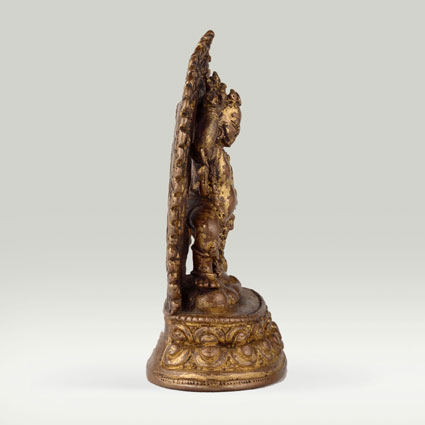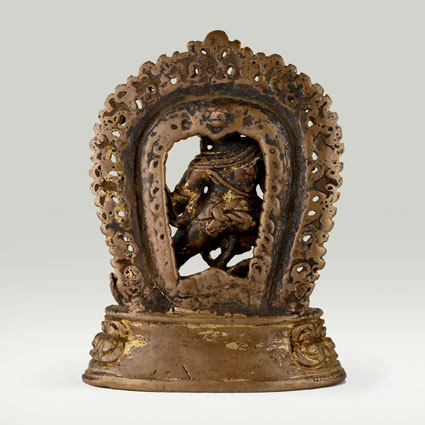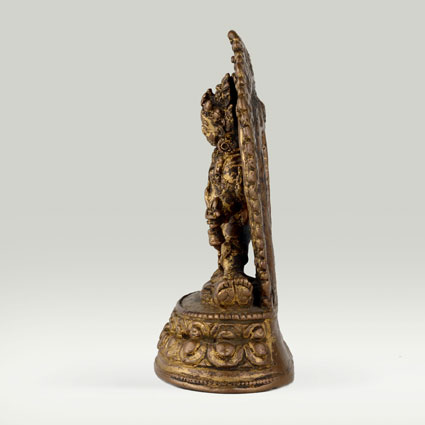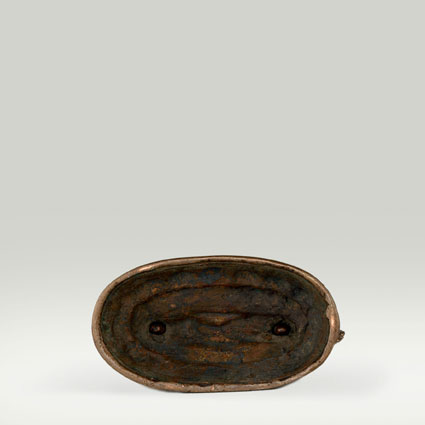Nila Vajravidarana – The "Blue Adamantine Subjugator"
See it in the Museum
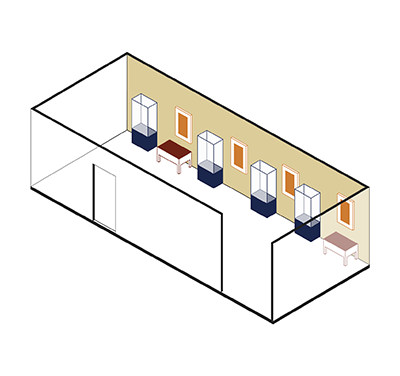
India and Nepal
Orientation 3
Display 5

ABS 152
Code: ABS 152
Country: Nepal (west)
Style: Khasha Malla
Date: 1250 - 1350
Dimensions in cm WxHxD: 9.2 x 12.2 x 5.1
Materials: Gilt copper
Nila-Vajravidarana – The "Blue Adamantine Subjugator"
This wrathful form of Vajrapani, known as Nila-Vajravidarana, is stepping out to the right in the warrior stance, trampling on a corpse laid out upon a double lotus pedestal. The corpse represents an inner demon that he has overcome. He brandishes a five-pronged vajra sceptre in the right uplifted hand and holds a bell (ghanta) in the left hand. This gilded copper image was presumably cast by a Newari artist for Kasha Malla patrons of Western Nepal. Many of the statues attributed to the Kasha Malla kingdom have distinct lotus pedestals.
Vajrapani is one of the earliest bodhisattvas of Mahayana Buddhism. He was depicted extensively in Buddhist iconography as one of the three protective deities surrounding the Buddha. Each of them symbolizes one of the Buddha's virtues: Manjushri (the manifestation of all the Buddhas' wisdom), Avalokiteshvara (the manifestation of all the Buddhas' compassion) and Vajrapani (the manifestation of all the Buddhas' power). For the yogin or the yogini, Vajrapani is a means of accomplishing fierce determination and symbolizes unrelenting effectiveness in the conquest of negativity.
This wrathful form of Vajrapani, known as Nila-Vajravidarana, is stepping out to the right in the warrior stance, trampling on a corpse laid out upon a double lotus pedestal. The corpse represents an inner demon that he has overcome. He brandishes a five-pronged vajra sceptre in the right uplifted hand and holds a bell (ghanta) in the left hand. This gilded copper image was presumably cast by a Newari artist for Kasha Malla patrons of Western Nepal. Many of the statues attributed to the Kasha Malla kingdom have distinct lotus pedestals.
Vajrapani is one of the earliest bodhisattvas of Mahayana Buddhism. He was depicted extensively in Buddhist iconography as one of the three protective deities surrounding the Buddha. Each of them symbolizes one of the Buddha's virtues: Manjushri (the manifestation of all the Buddhas' wisdom), Avalokiteshvara (the manifestation of all the Buddhas' compassion) and Vajrapani (the manifestation of all the Buddhas' power). For the yogin or the yogini, Vajrapani is a means of accomplishing fierce determination and symbolizes unrelenting effectiveness in the conquest of negativity.


